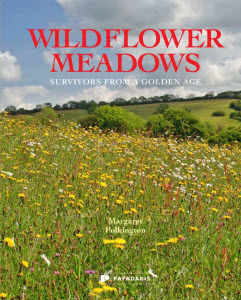 |
by Margaret Pilkington
Published by Papadakis, £25.
"This book is a celebration of meadows and their wildflowers. Once common-place and familiar to all, not many now remain and their typical flowers are rapidly becoming a folk memory. Stylised meadow flowers, evoking a by-gone era of rural idyll and permanent summer sunshine, are used to sell everything from tea-towels to china plates and cups. Here we reveal their true beauty with close-up photography of flower detail and more distant shots setting them in their meadow context. The 1800s are sometimes referred to as the Golden Age of Farming, but social history reveals a different story. Life was hard for the farm labourers and the picturesque cottages they lived in had leaking roofs, but nature and wildflowers thrived. The meadows and the wildflowers described in this book are survivors from this golden age: a time when there was a meadow full of wildflowers and butterflies down every lane".
There is no doubting that this book has been written by someone who not only is a real expert on old meadows but also is totally passionate about them. The book is very easy to leaf through and enjoy the stunning images of sunny meadows, blue skies, flowers and butterflies: all of these being very welcome sights in the wet start to the summer of 2012 as I review this.
The book sets out to be a celebration of traditional hay meadows and the wildlife they support whilst at the same time adding the perspective of their place in history and in our culture. Additionally the book aims to assist an understanding of these unique plant assemblages by reference to the National Vegetation Classification.
Every page has wonderful photographs that both inform and enthuse the reader and they help to explain the rich biodiversity that exists. And so does the text. It is not just a book containing pretty pictures, rather it details the relationships between plants and insects, particularly butterflies and bees. The special role of moths in relation to orchids is mentioned too but more mentions of moths would have been welcome as a number of rare moths are associated with ancient meadows and overall their value as pollinators is greater than that of butterflies. On another small note of criticism, certain photographs do not carry the full name of the insect - just saying a bumblebee or Burnet moth, thus missing an opportunity to further educate the reader.
But no one should be discouraged by these minor adverse comments. The book is superb. One of the joys is the liberal sprinkling of quotations from poetry and prose that help to capture the nature of meadows in times gone by, as do the many snippets from old farmers. Sadly wildflower meadows hardly have a place in modern farming but maybe this book will help to bring about a change.
Although the introduction makes it clear that the book is not about sowing or planting wildflowers in the countryside, much information is given on good management techniques for old meadows. The splendid old photographs of haymaking and old machinery are set to conjure up childhood days in the hayfield and readers inclined towards nature conservation will warm to the sensitive descriptions of the conflicts that arise in management.
For those already familiar with old meadows the book will serve as a treasury of memories. It is so nice that many of the photographs are captioned with the name of the meadow. For those who have never visited one, this is the next best thing to walking around a meadow and an inspiration to see one soon.
Click here to see more images of the book, and for information on how to order.